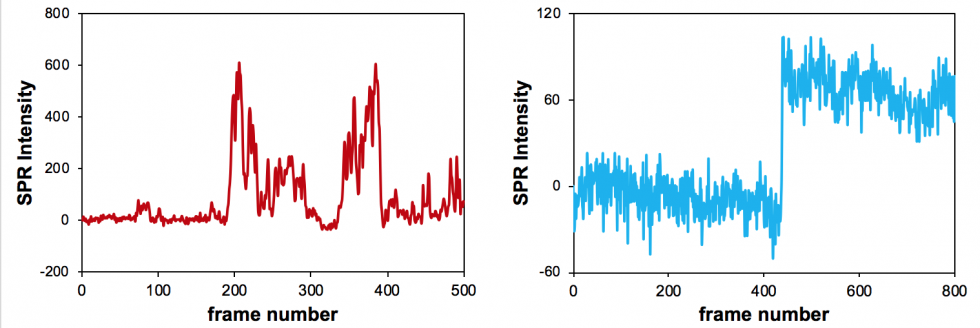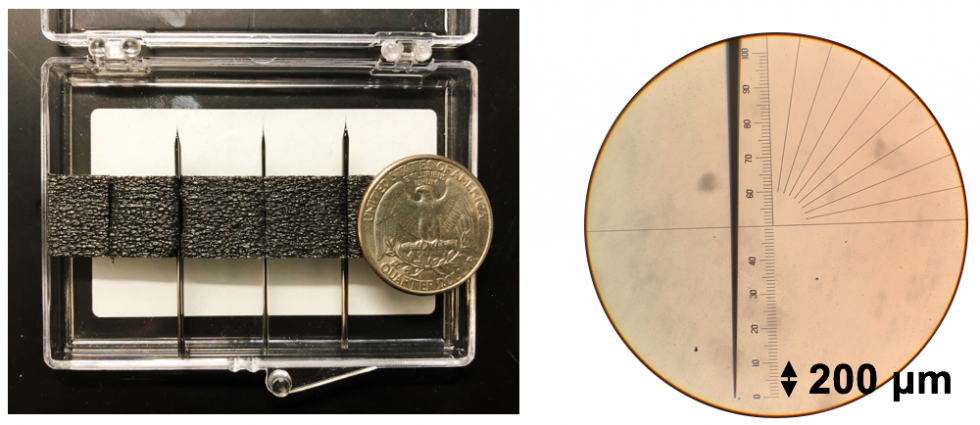1. Study the molecular interactions between α-synuclein (αS) aggregates and neuron membranes for understanding the pathological mechanism in Parkinson’s disease (PD). PD is the second most common neurodegenerative disorder disease involving dysfunction and death of dopaminergic neurons in the substantia nigra. The misfolding and aggregation of αS, a 140-residue soluble protein populated at presynaptic termini, is believed to lead to high neurotoxicity and plays an important role in the development and progression of PD. Our recent publication has demonstrated the real-time cell membrane disruption caused by αS aggregates added extracellularly. However, the exact mechanism by which the protein promotes the membrane disruption also remains largely uncertain. We are currently carrying out the following two approaches for deepening our understanding of the mechanism of cell membrane disruption: (1) perform quantitative measurement of the binding affinities and accumulation/aggregation profiles of different forms of αS at the surface of living cell membranes in individual neuroblastoma cells using SPRM. (2) 3D-visualize the membrane disruption process using AFM and SICM. We expect to directly “visualize” the development and progression of membrane disruptionon living cell membranes and correlate the process with kinetic information that can be obtained from SPRM in (1).
2. Structural and morphological effects of nanoparticles (NPs) on their electrocatalytic properties. Various nanomaterials have been studied and explored for catalysis and energy-related applications, because of their unique chemical and physical properties. The traditional ensemble methods provide only averaged properties of nanomaterials with different shapes and size in a typical sample. Characterizing nanomaterials at single entity level is thus essential to determine the relationship between the catalytic activities and the structure of the nanomaterials. SPRM is one of the optical techniques that has been recently applied to study nanomaterials that enables high-throughput characterization of individual nanoparticles. We use SPRM to carry out high-throughput comprehensive characterization of single nanoparticles (NPs) in size, surface charge, and electrochemical activities using commercial polystyrene and gold NPs as example. In our demo test with the SPRM, polystyrene and gold NPs have shown completely different activities: the former oscillates near the surface while the later directly binds to the surface. On the other hand, we are using underpotential deposition (UPD) of Pb as a model reaction to estimate the areas of the Au (100), Au (111), and Au (110) facets present on individual AuNPs via SPRM. The potentials of the UPD peaks in a cyclic voltammogram are dependent on the crystallinities of a substrate metal, and the relative abundance of the three Au facets can be determined from the charges of the corresponding UPD peaks. The information obtained from this process will be correlated with specific electrocatalytic reactions such as carbon dioxide reduction, oxygen reduction reaction and so on.
3. Fabrication and modification of carbon nanoelectrodes for intracellular detection of electrochemical active species. Reactive oxygen species (ROS), such as H2O2, can be detected electrochemically via amperometry, which is a label-free, highly-sensitive and quantitative technique, and has been widely used in biological studies. Nevertheless, previous metal nanoelectrodes are not small enough for non-invasive intracellular detection. We work on fabricating carbon nanoelectrodes (CNEs) that are under 100nm in diameter through chemical vapor deposition process (CVD). We are currently improving the process to achieve CNEs as small as 10nm in diameter. Further modification with platinum black or Prussian blue nanoparticles will be carried out and compared to figure out an idea way to improve the sensitivity of CNEs. We are also collaborating with Dr. Hui Yu from Shanghai Jiaotong University by providing nanoelectrodes for their single vesicle collision studies.
4. Real-time monitoring of particulate matter (PM2.5) in air sample via a novel hybrid imaging system. According to the American Lung Association “State of the Air 2018” report, LA metropolitan area remains one of the most polluted in the United States. As one of the major air pollution substances, particulate matter (PM) is a complex mixture of extremely small particles and liquid droplets and can cause serious health effects once inhaled. PM with a diameter of ≤2.5 micrometer (PM2.5) has been classified as a cause of cancer. Real-time monitoring of PM2.5 is critical for understanding the source of pollution, studying atmospheric models and providing regulatory and advisory guidelines for decreasing the pollution. We aim at developing a novel hybrid imaging system for real-time motoring the size, morphology, hardness, and eventually chemical properties of PM2.5 in air samples. High-resolution topographic and mechanical images of a particle generated from burning an incense stick can be obtained using AFM in our hybrid imaging system; on the other hand, SPRM function in the same system enables monitoring the landing of particles on sensing surface in real time. In the future, we hope to further investigate the chemical properties of PM2.5.


